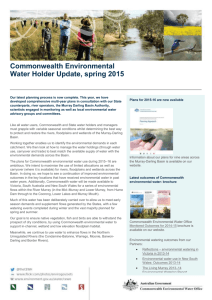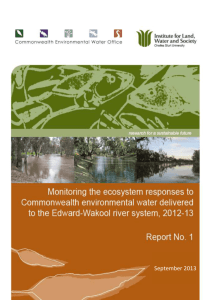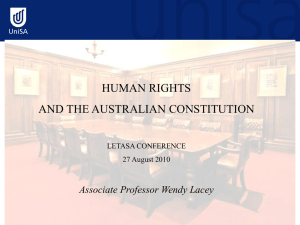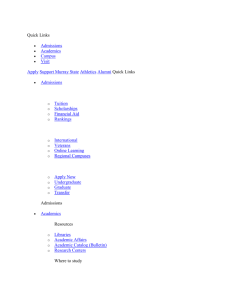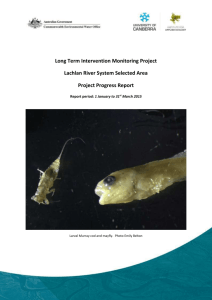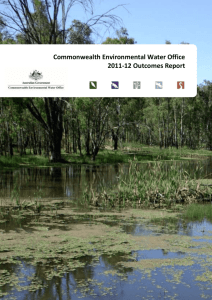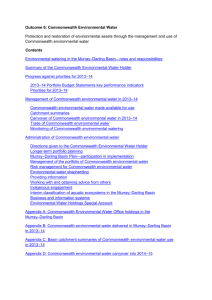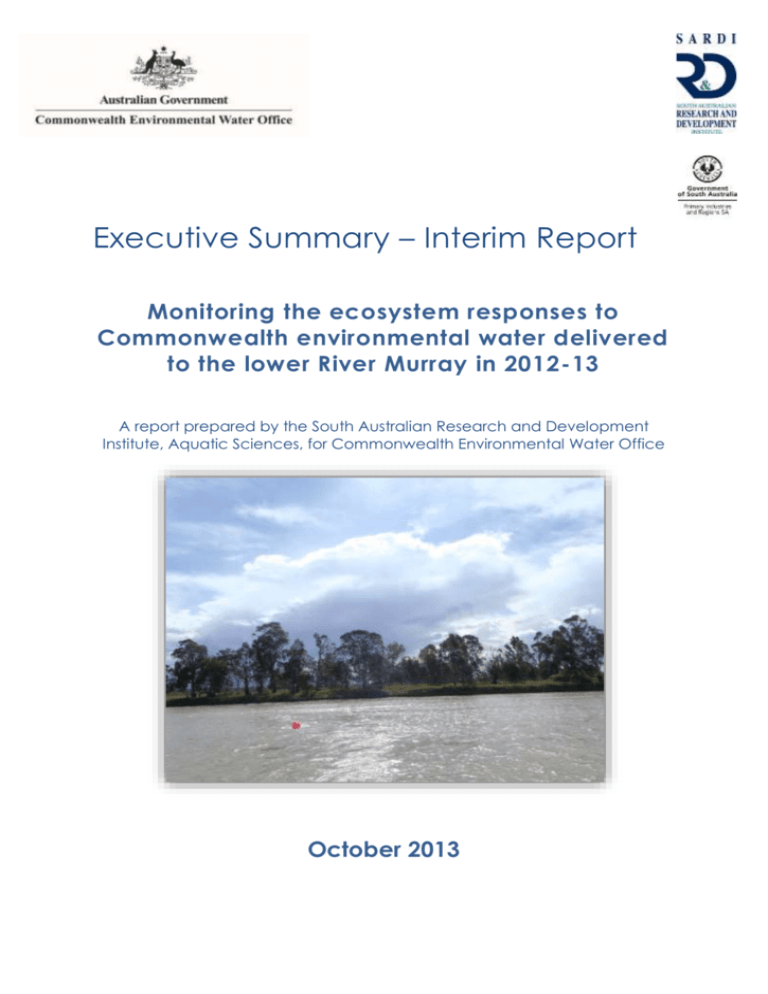
Executive Summary – Interim Report
Monitoring the ecosystem responses to
Commonwealth environmental water delivered
to the lower River Murray in 2012-13
A report prepared by the South Australian Research and Development
Institute, Aquatic Sciences, for Commonwealth Environmental Water Office
October 2013
Ye et al. (2013) Ecosystem response to Commonwealth environmental watering in the lower River Murray in 201213. Interim report.
Ye, Q.1, Livore, J.1, Aldridge, K.2, Bradford, T. 3, Busch, B.2, Earl, J1., Hipsey, M.4, Lorenz,
Z.3, Oliver, R.3, Shiel, R.5, Suitor, L.6, Tan, L.5, Turner, R.6, and Wegener, I.6 (2013). Monitoring
the ecosystem responses to Commonwealth environmental water delivered to the lower River
Murray in 2012-13. Report 1, prepared for Commonwealth Environmental Water Office. South
Australian Research and Development Institute, Aquatic Sciences.
SARDI Aquatics Sciences
The University of Adelaide
3 CSIRO
4 The University of Western Australia
5 Wetland Research and Management
6 The Department of Environment, Water and Natural Resources
1
2
This monitoring project was commissioned by the Commonwealth Environmental Water Office
to the South Australian Research and Development Institute (SARDI), Aquatic Sciences. The
specific components of this project were sub-contracted to CSIRO (Task 2 & 3); The University of
Adelaide and the University of Western Australia (Task 4); the South Australian Department of
Environment, Water and Natural Resources (DEWNR) (Tasks 5 & 7) and Wetland Research and
Management (zooplankton work of Task 1). The project was funded by the Commonwealth
Environmental Water Office with in kind contributions from SARDI, CSIRO, South Australian
Murray-Darling Basin Natural Resources Management Board, DEWNR and South Australian
Environmental Protection Authority (EPA).
DISCLAIMER
The views and opinions expressed in this publication are those of the authors and do not
necessarily reflect those of the Australian Government or the Minister for Sustainability,
Environment, Water, Population and Communities. While reasonable efforts have been made
to ensure that the contents of this publication are factually correct, the Commonwealth does
not accept responsibility for the accuracy or completeness of the contents, and shall not be
liable for any loss or damage that may be occasioned directly or indirectly through the use of,
or reliance on, the contents of this publication.
© Commonwealth of Australia 2013
This work is copyright. You may download, display, print and reproduce this material in
unaltered form only (retaining this notice) for your personal, non-commercial use or use within
your organisation. Apart from any use as permitted under the Copyright Act 1968, all other
rights are reserved. Requests and enquiries concerning reproduction and rights should be
addressed to Department of Sustainability, Environment, Water, Population and Communities,
Public Affairs, GPO Box 787 Canberra ACT 2601 or email public.affairs@environment.gov.au
1
Ye et al. (2013) Ecosystem response to Commonwealth environmental watering in the lower River Murray in
2012-13. Interim report.
This project aimed to monitor the ecological responses to Commonwealth
environmental water releases to the lower River Murray in 2012-13. The lower
River Murray, including the lower Lakes and Coorong, encompasses a wide
range of aquatic habitat that support diverse species of native flora and
fauna, including threatened fishes, frogs, and riparian plants listed under the
Environmental Protection and Conservation Biodiversity Act (EPBC Act 1999).
This complex ecosystem is strongly influenced by variation in riverine flow
regime. During the prolonged drought that affected the Murray-Darling Basin
(2001-2010), the ecological community in the lower River Murray suffered
severe stress. The significant flood and high flows in the following years, along
with environmental water releases, led to signs of ecosystem improvement.
During 2012-13, a significant volume of Commonwealth environmental water
was released to the lower River Murray, with >687 GL delivered by July 2013, to
continue to facilitate the ecological recovery and rebuild ecosystem
resilience. During the spring/summer period, 383 GL of Commonwealth
environmental water and 289 GL of water from The Living Murray Initiative were
used to contribute to fresh flows. Future references to environmental water in
this report refer to the delivery of both of these sources.
The focus of this project was to assess particular components of the ecosystem
in response to changes in flow of the lower River Murray caused by
environmental watering. Key components of the ecosystem were selected and
investigated through targeted, rigorous monitoring to help understand the role
and importance environmental water deliveries may have in this ecosystem.
The project was divided into 7 tasks in an attempt to address relevant
objectives of Commonwealth environmental watering for the lower River
Murray. Each task proposed a series of hypotheses, based on current
knowledge of the system, to be tested during the 2012-13 watering year.
This report presents the project progress to March 2013 and preliminary findings
of some tasks during the intervention monitoring in 2012-13, albeit based mainly
on observations and early trends.
Preliminary findings
2
Ye et al. (2013) Ecosystem response to Commonwealth environmental watering in the lower River Murray in
2012-13. Interim report.
Task 1 Larval fish assemblage (Fish reproduction and larval abundance):
Presence of golden and silver perch larvae in the January sampling suggests
that the normal reproduction period of these species may have been
extended. This extension could be associated to the release of environmental
water during the month of December that caused a rise in flow to ~20,000 ML
day-1. Two other iconic species larvae, Murray cod and freshwater catfish,
were also present in November and December sampling.
Task 2 Larval fish food resources (Primary productivity and carbon cycling):
Total organic carbon (TOC) varied 4 fold over the time of sampling. This would
be expected to result in changes in micro-organism community composition
and abundance in the river, with positive implications for larval fish food
resources. Euphotic depths of approximately 1m were found over the time
series. Visual identification and cell counts of phytoplankton have been
completed and the data is being collated. Cyanobacteria, Chlorophyta,
Baccillariophyceae and Charaphyta have been identified in the samples.
Task 6 Fish lateral movement (Biotic dispersal and movement): Sampling of fish
movement between wetlands and the river channel has collected 34,814 fish,
representing 16 species (11 natives, 5 invasive). The most abundant largebodied native species recorded was bony herring, while golden perch was
also collected in relatively high numbers. Large-bodied invasives were the
second most abundant group collected, with 9,471 individuals (27%) collected,
most of which were common carp. Preliminary outcomes showed that the
structure of fish assemblages moving ‘In’ and ‘Out’ of wetlands was not
significantly different for each of the four wetlands during each of the five flow
phases; although more detailed analyses are required to corroborate this.
Preliminary multivariate analyses indicate that fish assemblages in wetlands
changed considerably between the five different flow phases.
The gonadosomatic index (GSI) and macroscopic staging of females carp in
the Gorge region suggests that peak reproductive period for common carp
occurred during the unregulated ‘High’ flow phase which occurred in the
winter and into the ‘Receding’ flow phase. The peak reproductive period did
not appear to correspond to the increase in flows in late-spring/ early-summer,
3
Ye et al. (2013) Ecosystem response to Commonwealth environmental watering in the lower River Murray in
2012-13. Interim report.
associated with the delivery of environmental water flow pulse. The relatively
low GSIs throughout the five phases of flow sampled, suggests that the peak
reproductive period for the Floodplain, most likely occurred prior to this study.
Furthermore, the delivery of environmental water did not appear to enhance
carp spawning in 2012-13.
Task 7 Frog response (Other vertebrate diversity): A total of 8 frog species were
detected during the spring sampling but only 5 of those were again detected
during summer. Frequency of detection was also highest in spring. Upon
comparing regions, the floodplain region seemed to have greater frequency
of detection than the gorge region for most species. The most frequently
detected species were the Eastern Banjo frog, Spotted Grass frog, Eastern Signbearing froglet and Peron’s tree frog in that order for both regions. The
threatened Southern Bell frog was only recorded in spring in the floodplain
region.
Project progress and prospect
Fieldwork for all tasks was successful and has been finalised. Sample processing
and data analysis is currently being completed (see individual chapters for
details on each task). As per original arrangements a final report (Report 2)
with complete analyses, interpretations and management implications is
scheduled to be delivered in late 2013, and an updated final report (Report 3)
will be provided to include the study of fish recruitment and natal origin by April
2014.
4



